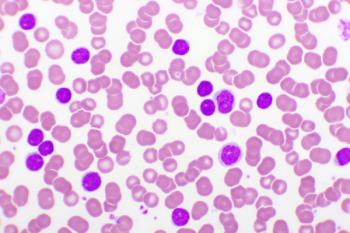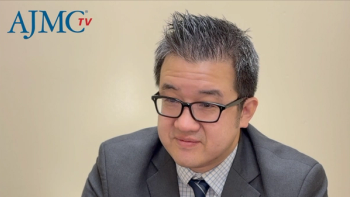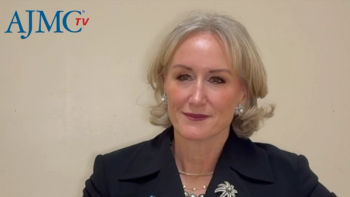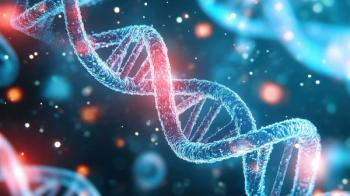
Epcoritamab Plus Chemoimmunotherapy Yields 87% Response Rate in R/R DLBCL; 65% Proceed to Transplant
Key Takeaways
- Epcoritamab plus chemoimmunotherapy achieved an 87% overall response rate in relapsed/refractory DLBCL patients, with 65% achieving complete response.
- The regimen offers a potential bridge to ASCT or CAR T-cell therapy, especially for high-risk patients with aggressive disease.
Results show the regimen of epcoritamab plus R-ICE could serve most patients as a bridge to either autologous stem cell transplant or CAR T-cell therapy.
Previously treated patients with
The data were from EPCORE NHL-2 (NCT04663347), a multi-arm, phase 1b/2 clinical trial evaluating the safety and efficacy of epcoritamab (Epkinly; Genmab, AbbVie) in various combinations to treat subtypes of B-cell non-Hodgkin lymphoma (B-NHL), in patients both previously treated and newly diagnosed.
Epcoritamab is a bispecific antibody that targets CD20 on B cells and CD3 on T-cells. Given subcutaneously, it is approved to treat patients with
In contrast with
Where possible, a goal in DLBCL treatment is to kill enough cancer cells to administer ASCT, which can restore the bone marrow's ability to produce healthy blood cells.
Thus, results for the R/R DLBCL population in EPCORE-NHL-2 were encouraging. This arm treated patients with R/R DLBCL with epcoritamab plus rituximab, ifosfamide, carboplatin, and etoposide (R-ICE), and results point the regimen offering a path to either ASCT or CAR T-cell therapy, if needed.
“These results are particularly encouraging because many of the patients in this study had high-risk disease, having progressed rapidly after initial treatment,” lead author Raul Cordoba, MD, PhD, head of the Lymphoma Unit at the Fundacion Jimenez Diaz University Hospital, Madrid, Spain, said
“This combination therapy of epcoritamab plus rituximab, ifosfamide, carboplatin, and etoposide (R-ICE) offers a potential new treatment option for patients with relapsed/refractory diffuse large B-cell lymphoma, providing high response rates and a bridge to potentially curative autologous stem cell transplantation."
After a step-up dosing schedule in cycle 1, 48 mg doses of epcoritamab were given once weekly through cycle 4, then every 2 weeks for cycles 5-9, and then every 4 weeks for cycle 10 and beyond. R-ICE was given every 3 weeks through cycle 4 and then every 4 weeks until patients received ASCT, had progressive disease, or experienced unacceptable toxicity. The primary end point was ORR per investigator assessment.
Patient characteristics were as follows:
- As of the data cutoff December 18, 2024, median follow-up was 11 months, with a range of 6 to 15 months.
- 31 patients received epcoritamab at the full dose plus R-ICE. Median age was 62 years, with a range from 39 to 77 years.
- 55% were male, 61% were Ann Arbor stage III/IV, and 42% had bulky disease (at least 7 cm); 81% had 1 prior line of therapy (range, 1-3 lines) and 65% had progressed within 12 months of their first line of treatment.
Results were as follows:
- In the group of 31 patients receiving epcoritamab plus R-ICE, ORR was 87%, with 20 patients (65%) having a complete response (CR) and 7 (23%) having a partial response.
- High ORRs and CR rates were seen whether or not patients had progressed before 12 months with their prior therapy, and whether they had 1 or more than 1 prior therapy.
- The median number of treatment cycles initiated was 4 (range, 2-14) for epcoritamab and 3 (range, 2-3) for R-ICE.
- Twenty patients (65%) proceeded to ASCT. On the last scan before ASCT, 13 of the 20 patients had a CR and 7 of 20 were in PR; 5 of 7 with PR reached CR after transplant.
- Of the 11 patients not going to transplant, 3 (10%) stayed on epcoritamab, with 1 in CR and 2 in PR.
- 8 patients (26%) discontinued treatment; 6 were due to progressive disease. Of the 8 patients, 6 proceeded to subsequent treatment, including 3 to CAR T-cell therapy, 1 to allogeneic SCT, and 1 to another clinical trial.
- At 6 months, an estimated 81% of responses were ongoing, with 74% patients deemed progression-free. All patients were alive.
Adverse events (AEs). The most common treatment-emergent AEs were neutropenia, seen in 74% of patients, anemia (68%) and thrombocytopenia (68%). About half (52%) experienced cytokine release syndrome, all grade 1-2 and resolved.
One patient had immune effector cell-associated neurotoxicity syndrome, grade 1, which resolved. No clinical tumor lysis syndrome was reported. Eighteen patients (58%) had infections, with 5 (16%) having serious infections. No patients stopped epcoritamab due to TEAEs.
Authors said the results show that epcoritamab, when combined with chemoimmunotherapy, “may optimize salvage treatment, increasing the proportion of patients proceeding to ASCT compared with historical rates, providing a greater chance of a cure.”
Reference
Cordoba R, Trneny M, DeVos S, et al. First disclosure of epcoritamab plus R-ICE in patients with relapsed/refractory diffuse large B-cell lymphoma (RR/ DLBCL) eligible or autologous stem cell transplant (ASCT): EPCORE-NHL-2. Presented at: 30th European Hematology Association Congress, Milan, Italy; June 12-15, 2025. Abstract S245.
Newsletter
Stay ahead of policy, cost, and value—subscribe to AJMC for expert insights at the intersection of clinical care and health economics.









































